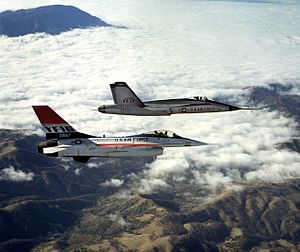| Lightweight Fighter (LWF) | |
|---|---|
 A YF-16 and a YF-17, flying side-by-side, armed with AIM-9 Sidewinder missiles | |
| General information | |
| Project for | Light fighter |
| Issued by | United States Air Force |
| Proposals | Boeing, General Dynamics, Lockheed, Northrop, and Vought |
| Prototypes | General Dynamics YF-16 Northrop YF-17 |
| History | |
| Outcome | F-16 selected for production |
| Related | Navy Air Combat Fighter |
The Lightweight Fighter (LWF) program was a United States Air Force technology evaluation program initiated in the late 1960s by a group of officers and defense analysts known as the "Fighter Mafia". It was spurred by then-Major John Boyd's 'energy-maneuverability' (E-M) theory, which indicated that excessive weight would have severely debilitating consequences on the maneuverability of an aircraft. Boyd's design called for a light-weight fighter with a high thrust-to-weight ratio, high maneuverability, and a gross weight of less than 20,000 lb (9,100 kg), half that of its counterpart, the McDonnell Douglas F-15 Eagle.[1] It resulted in the development of the General Dynamics YF-16 and Northrop YF-17. Late in the program, in 1974, with the promise of European sales, the Air Force changed the program name to Air Combat Fighter (ACF), and committed to purchasing 650 models of the YF-16, adopted as the F-16 Fighting Falcon. The U.S. Navy adopted a modified version of the YF-17 as the McDonnell Douglas F/A-18 Hornet.